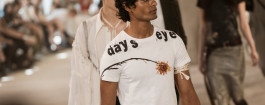
Capturing the essence of our time, it felt both grim and hopeful, creative and refined, innovative and rooted in tradition.
We loved every moment, jotting down the looks that made us jump from our seats, the shows that left a mark, and the concepts that will linger in our minds for a long time.
The week began with many designers showcasing their work at Der Berliner Salon, held at the Museum für Fotografie within the Helmut Newton Foundation. Set against Newton’s legendary photographs, these innovative designs felt like pieces of art themselves, perfectly embodying the creative and freedom-seeking spirit of Berlin – past, present, and future.
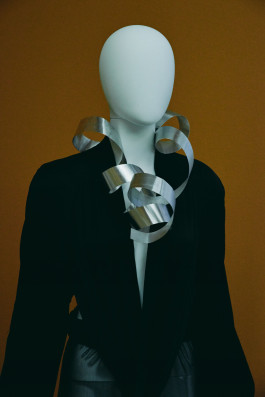
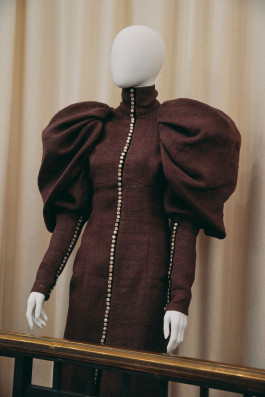
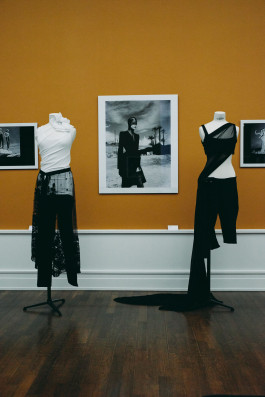
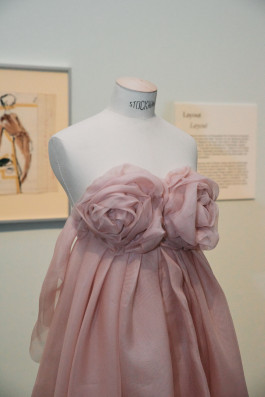
Of course, the concept of all-black is always present in Berlin’s fashion repertoire. Esther Perbandt, the queen of black, once again championed the color in an elaborate installation, featuring elements of menswear tailoring with contemporary twists.
“I like to combine East and West Berlin. I’m the glue between the two parts of Berlin,” said Esther Perbandt – a sentiment echoed in her installation, where the West Berlin–esque architecture of the Fashion Council Germany office met the iconic East Berlin Z chair in white by designer Eric Marker.
Esther Perbandt is a true storyteller, and a traditional runway show can’t capture the elaborateness of her pieces. She also prefers to give each creation the attention it deserves rather than producing vast collections every season.
“There has been an evolution of the brand over the last five years, and you can now see where I truly want to go – it’s a premium brand, but with the DNA of Berlin in a luxurious fashion,” she added.
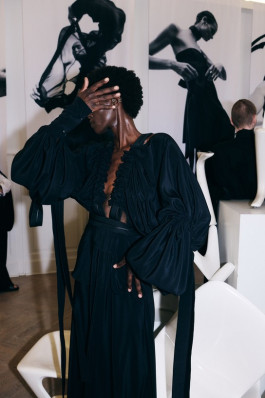
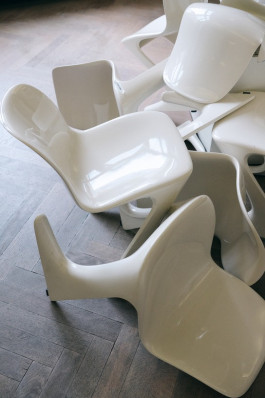
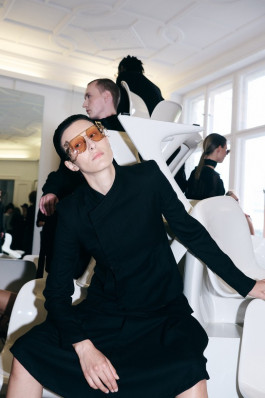
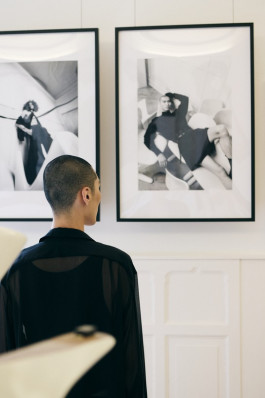
Another black master on the BFW scene was Ukrainian designer VIKTORANISIMOV. Showcasing his collection alongside The Feuerle Collection, he presented black tailoring in various shapes and forms, including bandage-like linens and uniform-inspired cuts.

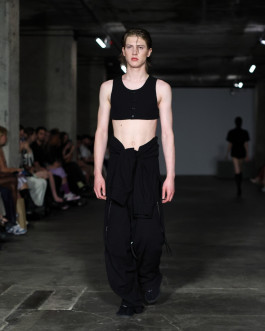


Fairytale elements, mythological references, and symbolic storytelling contributed to the fantasy-like atmosphere of Berlin Fashion Week SS26.
Danny Reinke explored medieval aesthetics in his collection “The Hunt,” focusing on earthy tones, sustainable fabrics, and storytelling. With his collection, the designer sends a message of fighting for what you love, for freedom.
“The collection is inspired by the seven tapestries depicting the hunt of the unicorn, and I wanted to bring that story to life,” said Reinke. “To me, the unicorn symbolizes freedom – something we’re losing in terms of economy, sustainability, and society.”
As the Lead Hair Stylist for Danny Reinke, Daniel Felix Bruns was tasked with evoking the medieval era in which the story is set - through hair. "We created long ponytails – not the classic ones, but wider, more textured versions, with plenty of greys," explained Daniel Felix.
Reinke’s work followed a sustainable process, using both new materials and collected, recycled items to give them a new identity. “The first piece in the collection is entirely handwoven from leftover yarns. I also went to flea markets searching for jewelry, cut it apart, sewed it on, and created a fully embroidered dress,” he shared.
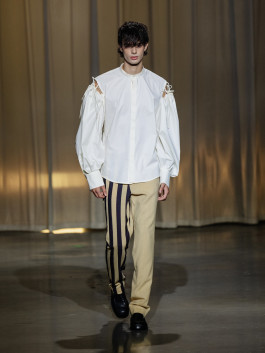
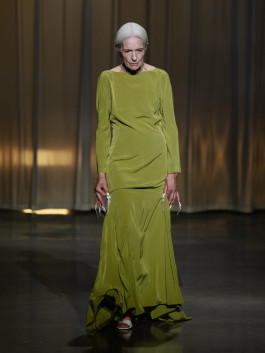
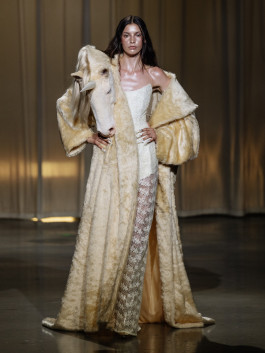

LUEDER’s SS26 collection, titled “SL∀Y,” was an exploration of dragons, medieval armor, and alchemical symbolism. The runway was dominated by shimmering fabrics resembling dragon scales, metallic leather breastplates, and layered skirts that conveyed power and fantasy. The dramatic silhouettes were achieved through exaggerated shoulders and cinched waists.
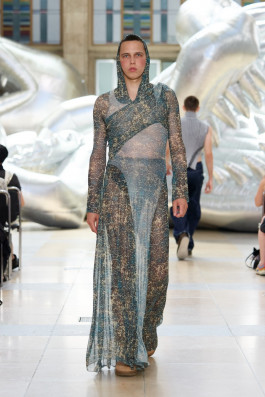
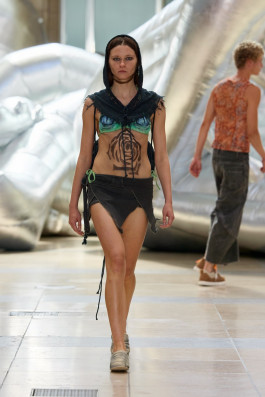
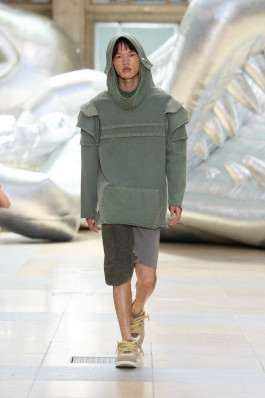
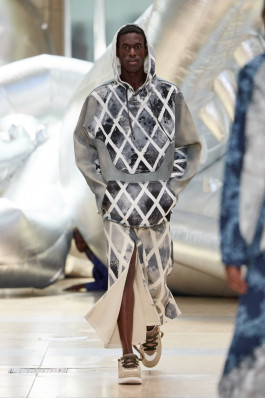
Ottolinger also brought their signature avant-garde, deconstructed style that captured the chaos and creativity of Berlin’s underground culture. Some of the standouts included distorted cargo pants, strappy tops pieced together like modern armor, and sculptural handbags with melted, abstract shapes.
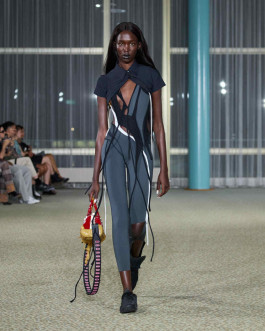
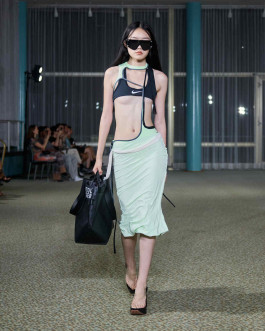
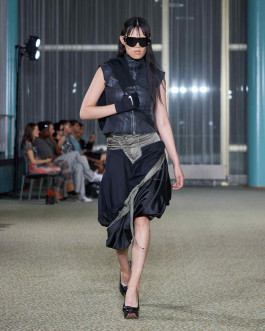

Milk of Lime’s SS26 collection, “CHIME,” told a story of rural nostalgia and childhood memories of bells ringing through alpine villages. Models wore poetic-punk looks, with asymmetrical dresses and tops adorned in delicate brass chime details that jingled as they moved.
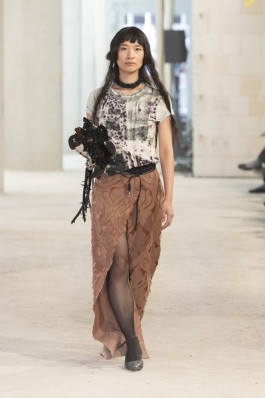
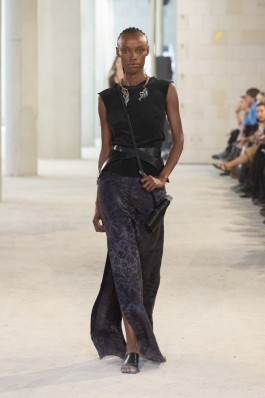
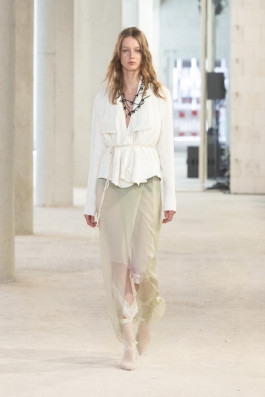
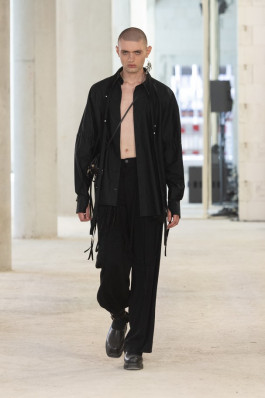
In Hangar 6, Haderlump’s “The Aviator” show paid tribute to early aviation pioneers, presenting looks that blend tailored, heritage-inspired outerwear with flowing, feminine dresses, symbolizing both the sturdy structure of planes and the freedom of flight.
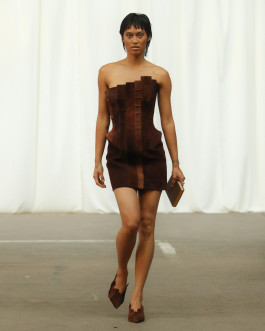
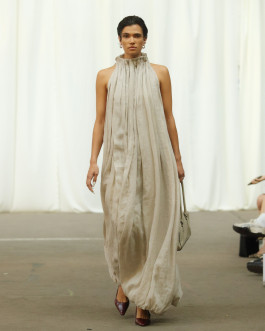
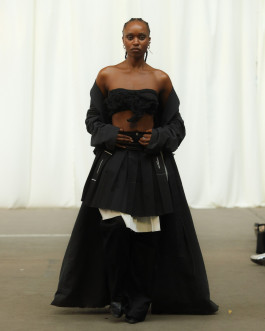
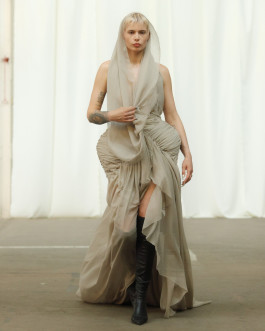
SF1OG’s “Cupid’s Whisper” focused on romantic longing, using vintage-inspired fabrics such as faded damasks, delicate lace overlays, and distressed velvets, woven into draped blouses with oversized sleeves and tailored trousers.
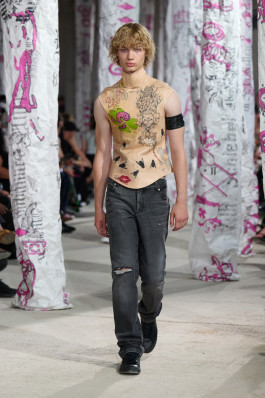
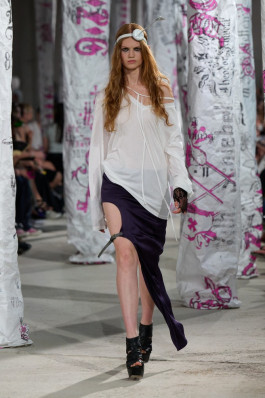
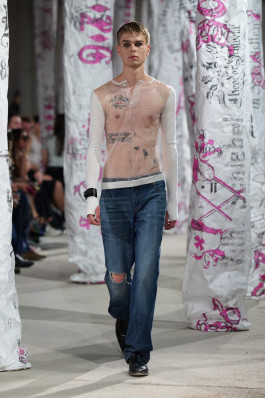
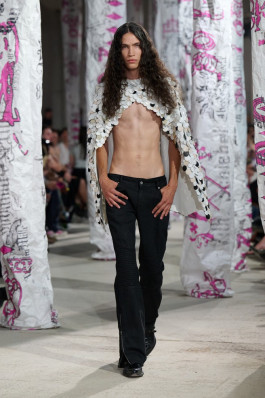
Continuing the theme of nostalgia, several designers chose to retell painful pasts through fashion.
Kilian Kerner confronted the traumatic history of children forcibly taken from their families for political reasons in his collection “DDR: The Stolen Children.” He juxtaposed military-inspired tailoring with delicate, flowing fabrics to symbolize oppression and resilience, intensified by an eerie soundtrack of archival speeches and lullabies.
"Killian Kerner’s show has a very strong message," says Lead Hair Stylist Daniel Felix Bruns. "He wanted to have a unique ‘80s style. For that, we created a technique which gave us the illusion of a proper ‘80s perm, with all of its fuzziness. It wasn’t supposed to look ‘pretty pretty’, but rather wild and messy.”
Gerrit Jacob’s “Money Talks” was a satirical commentary on capitalism, with oversized streetwear pieces emblazoned with photorealistic prints of banknotes, coins, and luxury logos.
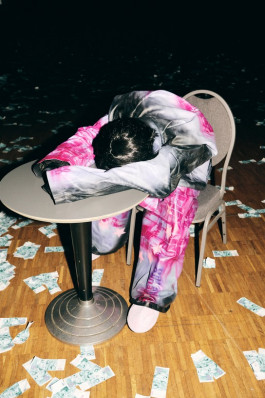
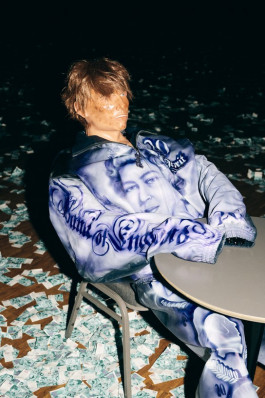
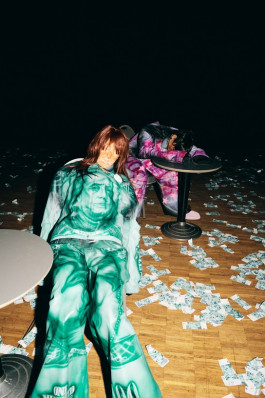
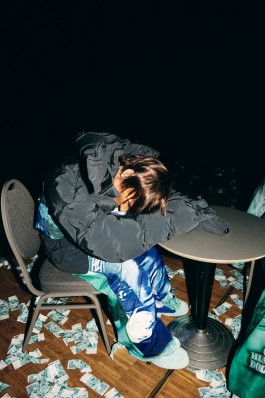
Marcel Ostertag explored the theme of “Paradise,” a continuation of his SS25 collection “Eden,” but infused with a ‘70s/’80s vibe. In a typical ethereal Marcel Ostertag fashion, the designer showcased flared pants with frills, lace dresses, and technicolor patterns. His hippie meets boho meets glam collection offered a hopeful outlook for a vintage vibe revival, with its freedom-seeking undertone.
The hair, of course, complemented Ostertag's love for '70s/'80s-inspired celebration. "He really wanted to create that sleek, model look with shiny hair," said Lead Hair Stylist Daniel Felix. "It's a skill that might look simple, but it’s actually quite challenging to achieve, and the team executed it beautifully.”
Anja Gockel is another designer who loves color, contrary to the predominantly black trend in Berlin. She opened the show with a speech about compassion and kindness, setting a reflective mood.
“My latest collection is called Von welchen Farben träumt dein Glück?, which means ‘From which color does you luck dream?’” said Gockel. “As a fashion designer, colors are synonymous with happiness for me.”
Gockel has been designing sustainable fashion for 30 years now. “I have four children, and I don’t want to leave this world worse than I found it. What you believe in is important, and I express that through my fashion,” she added.
Marc Cain’s SS26 show at Kraftwerk explored the idea of a “Quiet Rebellion” through clothes that balanced timeless elegance with subtle subversion. The collection featured classic tailoring reinvented with unusual color blocking and unexpected cuts, such as asymmetric lapels or peekaboo slashes revealing neon linings.
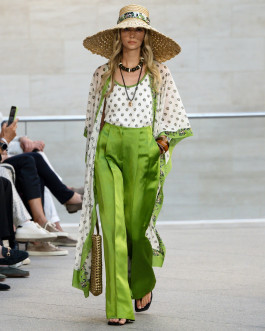
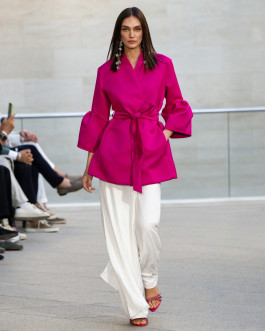
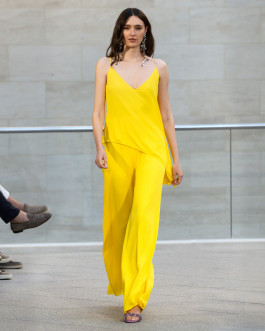
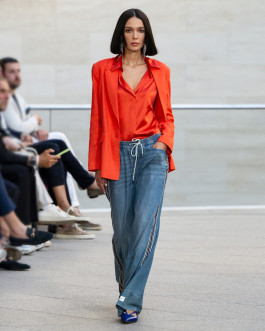
The Lagos-based brand Orange Culture also brought a medley of colors in “Trapped in Love”, exploring themes of love, vulnerability, masculinity, and mental health. It featured sheer layers, vibrant embroidery, bold prints, gender-fluid silhouettes, and statement outwear.
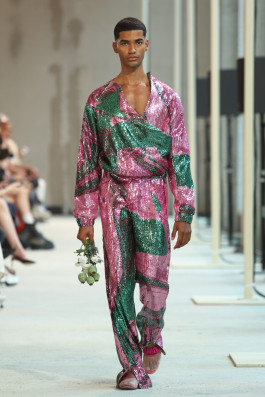
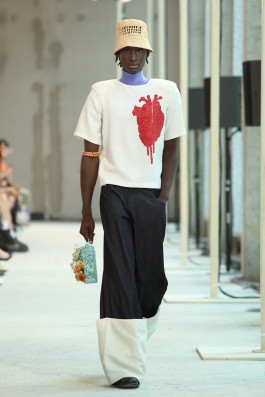
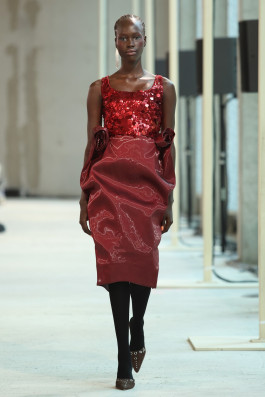
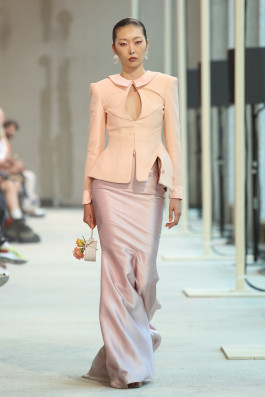
And then there were the parties. KitKat Club hosted the neon swimwear-inspired collection of #DAMUR, followed by a techno party lasting until dawn, complete with poolside photo sessions and a swimwear dress code for everyone.
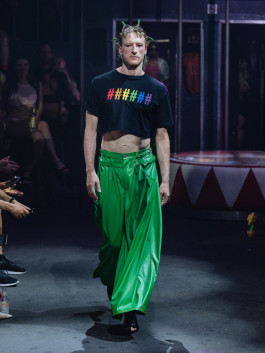
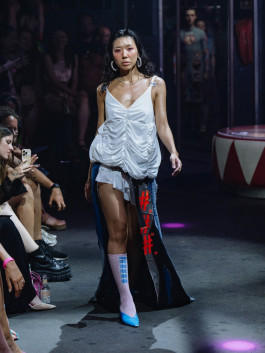

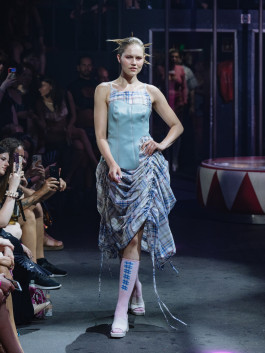
At Dark Matter, techno and clubwear store The Code presented several brands showcasing kinky and fetish-inspired outfits made from latex, rhinestones, and daring silhouettes, accompanied by spectacular performances by The Velvet Creepers and yet another after-show party with techno DJs spinning until late.
Berlin Fashion Week isn’t just about the runway. Numerous side events took place, including The Columbist’s own evening of fashion featuring guest speaker Donald Schneider, as well as panels highlighting the latest in fashion technology, AI, and sustainability, such as Future Fashion Lab, Metamorphosis, and Future Fashion Concepts.
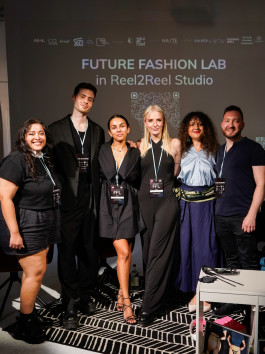
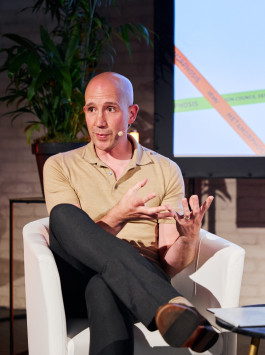
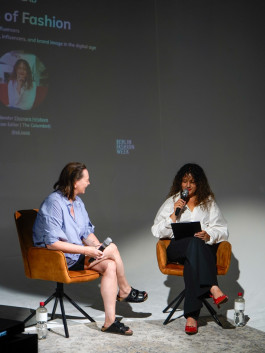
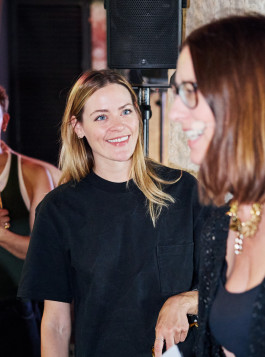
Related Articles:

Capturing the essence of our time, it felt both grim and hopeful, creative and refined, innovative and rooted in tradition.
We loved every moment, jotting down the looks that made us jump from our seats, the shows that left a mark, and the concepts that will linger in our minds for a long time.
The week began with many designers showcasing their work at Der Berliner Salon, held at the Museum für Fotografie within the Helmut Newton Foundation. Set against Newton’s legendary photographs, these innovative designs felt like pieces of art themselves, perfectly embodying the creative and freedom-seeking spirit of Berlin – past, present, and future.




Of course, the concept of all-black is always present in Berlin’s fashion repertoire. Esther Perbandt, the queen of black, once again championed the color in an elaborate installation, featuring elements of menswear tailoring with contemporary twists.
“I like to combine East and West Berlin. I’m the glue between the two parts of Berlin,” said Esther Perbandt – a sentiment echoed in her installation, where the West Berlin–esque architecture of the Fashion Council Germany office met the iconic East Berlin Z chair in white by designer Eric Marker.
Esther Perbandt is a true storyteller, and a traditional runway show can’t capture the elaborateness of her pieces. She also prefers to give each creation the attention it deserves rather than producing vast collections every season.
“There has been an evolution of the brand over the last five years, and you can now see where I truly want to go – it’s a premium brand, but with the DNA of Berlin in a luxurious fashion,” she added.




Another black master on the BFW scene was Ukrainian designer VIKTORANISIMOV. Showcasing his collection alongside The Feuerle Collection, he presented black tailoring in various shapes and forms, including bandage-like linens and uniform-inspired cuts.




Fairytale elements, mythological references, and symbolic storytelling contributed to the fantasy-like atmosphere of Berlin Fashion Week SS26.
Danny Reinke explored medieval aesthetics in his collection “The Hunt,” focusing on earthy tones, sustainable fabrics, and storytelling. With his collection, the designer sends a message of fighting for what you love, for freedom.
“The collection is inspired by the seven tapestries depicting the hunt of the unicorn, and I wanted to bring that story to life,” said Reinke. “To me, the unicorn symbolizes freedom – something we’re losing in terms of economy, sustainability, and society.”
As the Lead Hair Stylist for Danny Reinke, Daniel Felix Bruns was tasked with evoking the medieval era in which the story is set - through hair. "We created long ponytails – not the classic ones, but wider, more textured versions, with plenty of greys," explained Daniel Felix.
Reinke’s work followed a sustainable process, using both new materials and collected, recycled items to give them a new identity. “The first piece in the collection is entirely handwoven from leftover yarns. I also went to flea markets searching for jewelry, cut it apart, sewed it on, and created a fully embroidered dress,” he shared.




LUEDER’s SS26 collection, titled “SL∀Y,” was an exploration of dragons, medieval armor, and alchemical symbolism. The runway was dominated by shimmering fabrics resembling dragon scales, metallic leather breastplates, and layered skirts that conveyed power and fantasy. The dramatic silhouettes were achieved through exaggerated shoulders and cinched waists.




Ottolinger also brought their signature avant-garde, deconstructed style that captured the chaos and creativity of Berlin’s underground culture. Some of the standouts included distorted cargo pants, strappy tops pieced together like modern armor, and sculptural handbags with melted, abstract shapes.




Milk of Lime’s SS26 collection, “CHIME,” told a story of rural nostalgia and childhood memories of bells ringing through alpine villages. Models wore poetic-punk looks, with asymmetrical dresses and tops adorned in delicate brass chime details that jingled as they moved.




In Hangar 6, Haderlump’s “The Aviator” show paid tribute to early aviation pioneers, presenting looks that blend tailored, heritage-inspired outerwear with flowing, feminine dresses, symbolizing both the sturdy structure of planes and the freedom of flight.




SF1OG’s “Cupid’s Whisper” focused on romantic longing, using vintage-inspired fabrics such as faded damasks, delicate lace overlays, and distressed velvets, woven into draped blouses with oversized sleeves and tailored trousers.




Continuing the theme of nostalgia, several designers chose to retell painful pasts through fashion.
Kilian Kerner confronted the traumatic history of children forcibly taken from their families for political reasons in his collection “DDR: The Stolen Children.” He juxtaposed military-inspired tailoring with delicate, flowing fabrics to symbolize oppression and resilience, intensified by an eerie soundtrack of archival speeches and lullabies.
"Killian Kerner’s show has a very strong message," says Lead Hair Stylist Daniel Felix Bruns. "He wanted to have a unique ‘80s style. For that, we created a technique which gave us the illusion of a proper ‘80s perm, with all of its fuzziness. It wasn’t supposed to look ‘pretty pretty’, but rather wild and messy.”
Gerrit Jacob’s “Money Talks” was a satirical commentary on capitalism, with oversized streetwear pieces emblazoned with photorealistic prints of banknotes, coins, and luxury logos.




Marcel Ostertag explored the theme of “Paradise,” a continuation of his SS25 collection “Eden,” but infused with a ‘70s/’80s vibe. In a typical ethereal Marcel Ostertag fashion, the designer showcased flared pants with frills, lace dresses, and technicolor patterns. His hippie meets boho meets glam collection offered a hopeful outlook for a vintage vibe revival, with its freedom-seeking undertone.
The hair, of course, complemented Ostertag's love for '70s/'80s-inspired celebration. "He really wanted to create that sleek, model look with shiny hair," said Lead Hair Stylist Daniel Felix. "It's a skill that might look simple, but it’s actually quite challenging to achieve, and the team executed it beautifully.”
Anja Gockel is another designer who loves color, contrary to the predominantly black trend in Berlin. She opened the show with a speech about compassion and kindness, setting a reflective mood.
“My latest collection is called Von welchen Farben träumt dein Glück?, which means ‘From which color does you luck dream?’” said Gockel. “As a fashion designer, colors are synonymous with happiness for me.”
Gockel has been designing sustainable fashion for 30 years now. “I have four children, and I don’t want to leave this world worse than I found it. What you believe in is important, and I express that through my fashion,” she added.
Marc Cain’s SS26 show at Kraftwerk explored the idea of a “Quiet Rebellion” through clothes that balanced timeless elegance with subtle subversion. The collection featured classic tailoring reinvented with unusual color blocking and unexpected cuts, such as asymmetric lapels or peekaboo slashes revealing neon linings.




The Lagos-based brand Orange Culture also brought a medley of colors in “Trapped in Love”, exploring themes of love, vulnerability, masculinity, and mental health. It featured sheer layers, vibrant embroidery, bold prints, gender-fluid silhouettes, and statement outwear.




And then there were the parties. KitKat Club hosted the neon swimwear-inspired collection of #DAMUR, followed by a techno party lasting until dawn, complete with poolside photo sessions and a swimwear dress code for everyone.




At Dark Matter, techno and clubwear store The Code presented several brands showcasing kinky and fetish-inspired outfits made from latex, rhinestones, and daring silhouettes, accompanied by spectacular performances by The Velvet Creepers and yet another after-show party with techno DJs spinning until late.
Berlin Fashion Week isn’t just about the runway. Numerous side events took place, including The Columbist’s own evening of fashion featuring guest speaker Donald Schneider, as well as panels highlighting the latest in fashion technology, AI, and sustainability, such as Future Fashion Lab, Metamorphosis, and Future Fashion Concepts.




Related Articles: